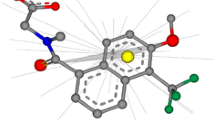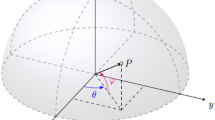Abstract
Ligand-based virtual screening is a well established method to find new lead molecules in todays drug discovery process. In order to be applicable in day to day practice, such methods have to face multiple challenges. The most important part is the reliability of the results, which can be shown and compared in retrospective studies. Furthermore, in the case of 3D methods, they need to provide biologically relevant molecular alignments of the ligands, that can be further investigated by a medicinal chemist. Last but not least, they have to be able to screen large databases in reasonable time. Many algorithms for ligand-based virtual screening have been proposed in the past, most of them based on pairwise comparisons. Here, a new method is introduced called mRAISE. Based on structural alignments, it uses a descriptor-based bitmap search engine (RAISE) to achieve efficiency. Alignments created on the fly by the search engine get evaluated with an independent shape-based scoring function also used for ranking of compounds. The correct ranking as well as the alignment quality of the method are evaluated and compared to other state of the art methods. On the commonly used Directory of Useful Decoys dataset mRAISE achieves an average area under the ROC curve of 0.76, an average enrichment factor at 1 % of 20.2 and an average hit rate at 1 % of 55.5. With these results, mRAISE is always among the top performing methods with available data for comparison. To access the quality of the alignments calculated by ligand-based virtual screening methods, we introduce a new dataset containing 180 prealigned ligands for 11 diverse targets. Within the top ten ranked conformations, the alignment closest to X-ray structure calculated with mRAISE has a root-mean-square deviation of less than 2.0 Å for 80.8 % of alignment pairs and achieves a median of less than 2.0 Å for eight of the 11 cases. The dataset used to rate the quality of the calculated alignments is freely available at http://www.zbh.uni-hamburg.de/mraise-dataset.html. The table of all PDB codes contained in the ensembles can be found in the supplementary material. The software tool mRAISE is freely available for evaluation purposes and academic use (see http://www.zbh.uni-hamburg.de/raise).








Similar content being viewed by others
References
Rogers D, Hahn M (2010) Extended-connectivity fingerprints. J Chem Inf Model 50:742–754
Finn PW, Morris GM (2013) Shape-based similarity searching in chemical databases. Wiley Interdiscip Rev Comput Mol Sci 3(3):226–241
Giganti D, Guillemain H, Spadoni JL, Nilges M, Zagury JF, Montes M (2010) Comparative evaluation of 3D virtual ligand screening methods: impact of the molecular alignment on enrichment. J Chem Inf Model 50:992–1004
Kirchmair J, Distinto S, Markt P, Schuster D, Spitzer GM, Liedl KR, Wolber G (2009) How to optimize shape-based virtual screening: choosing the right query and including chemical information. J Chem Inf Model 49:678–692
Grant JA, Gallardo MA, Pickup BT (1996) A fast method of molecular shape comparison: a simple application of a gaussian description of molecular shape. J Comput Chem 17(14):1653–1666
Vainio MJ, Puranen JS, Johnson MS (2009) ShaEP: molecular overlay based on shape and electrostatic potential. J Chem Inf Model 49:492–502
de Lima LAV, Nascimento AS (2013) MolShaCS: a free and open source tool for ligand similarity identification based on Gaussian descriptors. Eur J Med Chem 59:296–303
Roy A, Skolnick J (2015) LIGSIFT: an open-source tool for ligand structural alignment and virtual screening. Bioinformatics 31:539–544
Taminau J, Thijs G, De Winter H (2008) Pharao: pharmacophore alignment and optimization. J Mol Graph Model 27:161–169
Jain AN (2004) Ligand-based structural hypotheses for virtual screening. J Med Chem 47:947–961
Lemmen C, Lengauer T, Klebe G (1998) FLEXS: a method for fast flexible ligand superposition. J Med Chem 41:4502–4520
Abagyan R, Totrov M, Kuznetsov D (1994) Icma new method for protein modeling and design: applications to docking and structure prediction from the distorted native conformation. J Comput Chem 15(5):488–506
Totrov M (2008) Atomic property fields: Generalized 3D pharmacophoric potential for automated ligand superposition, pharmacophore elucidation and 3D QSAR. Chem Biol Drug Des 71(1):15–27
Huang N, Shoichet K, Irwin JJ (2006) Benchmarking sets for molecular docking. J Med Chem 49(23):6789–6801
Henzler AM, Urbaczek S, Hilbig M, Rarey M (2014) An integrated approach to knowledge-driven structure-based virtual screening. J Comput Aided Mol Des 28:927–939
Schomburg KT, Bietz S, Briem H, Henzler AM, Urbaczek S, Rarey M (2014) Facing the challenges of structure-based target prediction by inverse virtual screening. J Chem Inf Model 54:1676–1686
von Behren MM, Volkamer A, Henzler AM, Schomburg KT, Urbaczek S, Rarey M (2013) Fast protein binding site comparison via an index-based screening technology. J Chem Inf Model 53(2):411–422
Schellhammer I, Rarey M (2007) TrixX: structure-based molecule indexing for large-scale virtual screening in sublinear time. J Comput Aided Mol Des 21:223–238
Scharfer C, Schulz-Gasch T, Hert J, Heinzerling L, Schulz B, Inhester T, Stahl M, Rarey M (2013) CONFECT: conformations from an expert collection of torsion patterns. ChemMedChem 8:1690–1700
Mysinger MM, Carchia M, Irwin JJ, Shoichet BK (2012) Directory of useful decoys, enhanced (DUD-E): better ligands and decoys for better benchmarking. J Med Chem 55:6582–6594
Nittinger E, Schneider N, Lange G, Rarey M (2015) Evidence of water molecules-a statistical evaluation of water molecules based on electron density. J Chem Inf Model 55:771–783
Bietz S, Rarey M (2016) SIENA: efficient compilation of selective protein binding site ensembles. J Chem Inf Model 56:248–259
Hilbig M, Rarey M (2015) MONA 2: a light cheminformatics platform for interactive compound library processing. J Chem Inf Model 55:2071–2078
Stierand K, Maass PC, Rarey M (2006) Molecular complexes at a glance: automated generation of two-dimensional complex diagrams. Bioinformatics 22:1710–1716
OpenEye Scientific Software, Inc. (2015) ROCS method introduction. http://docs.eyesopen.com/rocs/introduction.html. Accessed Feb 2016
Author information
Authors and Affiliations
Corresponding author
Electronic supplementary material
Below is the link to the electronic supplementary material. The dataset used to rate the quality of the calculated alignments is freely available at http://www.zbh.uni-hamburg.de/mraise-dataset.html. The software tool mRAISE is freely available for evaluation purposes and academic use (see http://www.zbh.uni-hamburg.de/raise).
Rights and permissions
About this article
Cite this article
von Behren, M.M., Bietz, S., Nittinger, E. et al. mRAISE: an alternative algorithmic approach to ligand-based virtual screening. J Comput Aided Mol Des 30, 583–594 (2016). https://doi.org/10.1007/s10822-016-9940-1
Received:
Accepted:
Published:
Issue Date:
DOI: https://doi.org/10.1007/s10822-016-9940-1




